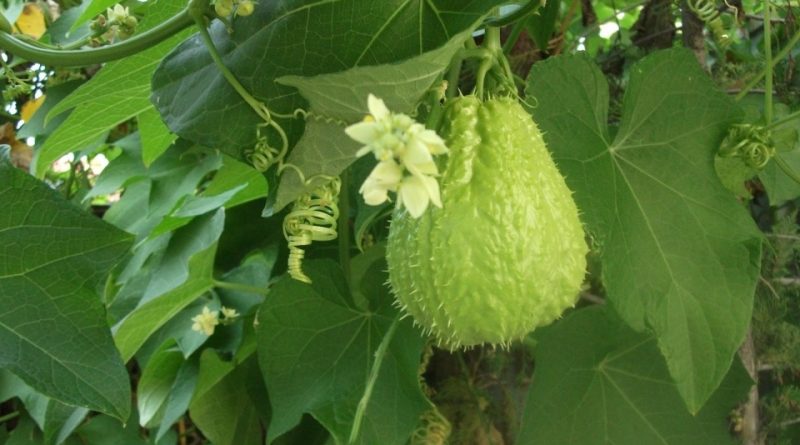Sechium edule
Sechium edule
The chayote (Sechium edule (Jacq.) Sw.) Is a climbing herbaceous species of the Cucurbitaceae family.
Systematics –
From the systematic point of view it belongs to the Eukaryota Domain, Kingdom Plantae, Magnoliophyta Division, Magnoliopsida Class, Violales Order, Cucurbitaceae Family and therefore to the Sechium Genus and to the S. Edule Species.
Etymology –
The generic term Sechium comes from the vernacular name used in the East Indies for a plant of this kind. The specific edule epithet derives from édo mangiare: edible.
The term usulae chayote is of Aztec origin (chayutli).
Geographic Distribution and Habitat –
The chayote is a herbaceous species native to South America and cultivated in the coastal areas of the continent and in the islands. It is also cultivated in Italy.
Description –
The Sechium edule is characterized by having ovoid fruits that can reach 15 cm in length; the superficial color can go from dark green (when the Chayote is unripe) to yellowish (ripe Chayote and therefore edible). The innermost part of the fruit is the embryo and the seed (botanical) of the plant, while all the surrounding pulp of the fruit is in large part a substance of accumulation and reserve of the same seed, (condition of viviparity), the whole, internal and external, therefore, constitutes the seed (in the horticultural sense) of the plant.
Presents some times of the characteristic needle-like growths that make it very recognizable and particular.
The plant is climbing and can also cover tens of square meters, flowering begins at the end of summer and the fruits are harvested between October and November.
Cultivation –
For the cultivation of this plant it is necessary to start from the sowing that is to be carried out by lightly grounding the whole fruit (less than half), as soon as it has released the leaf bud (in late spring). In fact, the fruit feeds the seed even after germination.
This plant does not need many water supplies and should be watered rarely to avoid causing seed rot. In order not to risk rot, you can plant the seed in a pot kept away from rains during the germination period, which lasts about twenty days. As soon as the seedling reaches 30-40 cm you can proceed with transplanting in full soil. For the cultivation technique, see the following sheet.
Uses and Traditions –
The Sechium edule is an edible plant, as well as its leaves and roots that at the end of spring can be treated as asparagus and therefore also preserved in oil or vinegar. The fruits, on the other hand, are kept in a cool place until the beginning of spring.
The largest exporter of Chayote is Costa Rica. It is also known in Italy, where it is called centenarian pumpkin, spiny courgette, spiny potato, spinach eggplant, American aubergine, wolf tongue: in fact it is correct to call it with its Italianized name from scientific name Sechium edule, then Sechio or with the Spanish name chayote.
100 grams of chayote contain 19 calories. Furthermore, for 100 g of this product, we have:
– Lipids 0,1 g
– Cholesterol 0 mg
– Sodium 2 mg
– Potassium 125 mg
– Glucides 4,5 g
– Dietary fiber 1.7 g
– Sugar 1.7 g
– Proteins 0.8 g
– Vitamin C 7.7 mg
– Calcium 17 mg
– 0.3 mg iron
– Magnesium 12 mg
The pulp and the seed are above all rich in amino acids, vitamin C, but above all vitamin B9, being one of the best vegetable sources. It also has good amounts of vitamins B6, B5 and K, and is a good source of many metals, first among which is zinc. It is used in many local medicines due to its diuretic, anti-inflammatory, hypotensive properties. In the western world it is indicated for kidney cleansing, in diabetic diets, for fetal formation in pregnant women, and is considered a food with anticancer properties.
Preparation Mode –
The chayote is used in cooking and cooked like a normal courgette: it is usually fried and seasoned with a little salt; it can be made stewed or boiled and seasoned like a salad or, still, roasted as a side dish, especially for red meat; very tasty sweet and sour, it can even be used candied for cakes and desserts in general.
Guido Bissanti
Sources
– Acta Plantarum – Flora of the Italian Regions.
– Wikipedia, the free encyclopedia.
– Treben M., 2000. Health from the Pharmacy of the Lord, Advice and experience with medicinal herbs, Ennsthaler Publisher
– Pignatti S., 1982. Flora of Italy, Edagricole, Bologna.
– Conti F., Abbate G., Alessandrini A., Blasi C. (edited by), 2005. An annotated checklist of the Italian vascular flora, Palombi Editore.
Warning: Pharmaceutical applications and alimurgical uses are indicated for informational purposes only and do not in any way represent a medical prescription; there is therefore no liability for their use for curative, aesthetic or food purposes.


